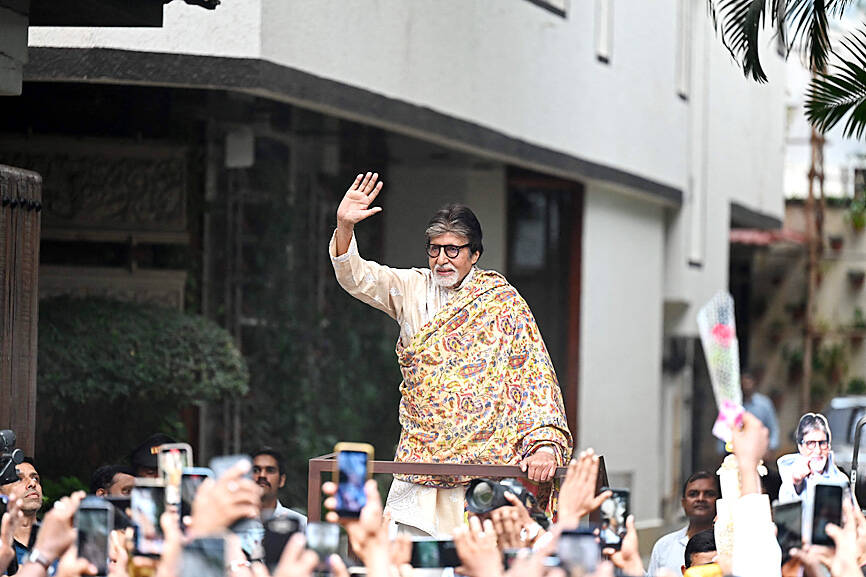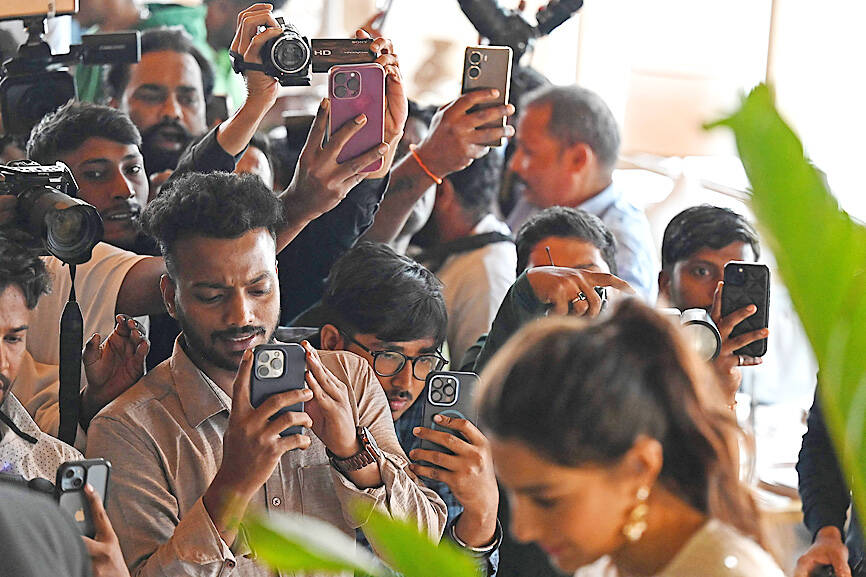From riding pillion on zooming motorbikes to round-the-clock airport stakeouts, India’s celebrity-hunting paparazzi photographers have gone from “outcasts” to becoming a key part of Bollywood’s vast film industry machine.
Times have changed for celebrity snapper Manav Manglani, who scored big at the wedding of Bollywood star Shilpa Shetty in 2009 by climbing a tree and perching on a branch for hours to spy over the venue’s walls.
“We ... were considered outcasts,” the photographer said, describing the early days of his trade.

Photo: AFP
Fifteen years later, Manglani pushes streams of content to more than 6.5 million followers on Instagram.
“We are part of the system now,” he said, commanding a squad of nearly 20 photographers who stake out popular gyms, chic cafes and luxury hotels, their phones buzzing with tips.
The team has divided the megacity into coverage zones, including someone stationed at the airport fulltime.

Photo: AFP
Mumbai-based Bollywood, the core of India’s Hindi-language film industry, is the longtime heart of moviemaking in the world’s most populous nation and a major cultural export.
In celebrity-obsessed India, it can be a lucrative trade.
Bollywood began a century ago, but it was in the 1970s that film magazines began publishing “inside” industry gossip, said Ram Kamal Mukherjee, a former editor-in-chief of Stardust magazine.
The Bollywood publication brought “stories from the studios, bedroom stories, stories from the makeup van,” he said.
The first wave of paparazzi began in India in the early 2000s, with freelance photographers chasing celebrities.
The insatiable demand by social media and ubiquitous availability of smartphones shifted gears again — with photographers no longer “just providing pictures,” but working to help produce a narrative, he said.
“Today there is intervention,” Mukherjee said, citing examples such as staged incidents where young actors seemingly spontaneously hand cash to beggars. “There is brand building.”
That has come alongside wider industry changes, including viewers shifting from the big screen.
Traditional blockbuster spectacles drawing crowds into cinemas have been challenged by long-format narratives on streaming platforms viewed at home, commonly called OTT or “over-the-top” services in India.
This has helped paparazzi develop a role in the publicity machine, observers say.
“Being an influencer with followers with a very popular page, helping them promote the movies, the OTT and the brands ... we are now important,” Manglani said.
Indian movies released in theatres raked in an “all-time high” of US$1.4 billion in box office revenue last year, according to consulting firm EY.
However, competition is fierce.
Mandvi Sharma, a former publicist for mega-star Shah Rukh Khan, said that the two sides can be “codependent,” especially for younger actors hoping photographers can boost their fame.
“Things have changed,” said Viral Bhayani, a photographer with more than 12 million Instagram followers, recalling how a decade ago he would have to “beg” for information about organized media events.
It has been quite a shift, “from being thrown out of places ... to now being called everywhere,” he said.
Bollywood also faces rising challenges from other Indian-language film centers. Of the country’s 1,796 cinema releases last year, just 218 were Bollywood’s traditional fare of Hindi-language movies, EY said.
Photographers now snap more candid images of celebrity daily lives, often more relatable to millions of fans than red carpet glamor or formal magazine shoots.
Despite their careers being more closely linked, old frictions remain, especially for big-name stars.
Last year, Bollywood star Alia Bhatt made a police complaint for “gross invasion” of privacy after two photographers took pictures of her at home from a neighboring rooftop.
However, Manglani said that his images are also a useful barometer to measure actors’ presence on the screen.
Producers, directors and the brands, “are keenly watching whom am I featuring ... what’s happening and what is the traction on that celebrity,” Manglani said. “We used to run behind them. We wanted money, we were earning by the picture... Now it’s both ways. They also need us, we also need them.”

‘UNUSUAL EVENT’: The Australian defense minister said that the Chinese navy task group was entitled to be where it was, but Australia would be watching it closely The Australian and New Zealand militaries were monitoring three Chinese warships moving unusually far south along Australia’s east coast on an unknown mission, officials said yesterday. The Australian government a week ago said that the warships had traveled through Southeast Asia and the Coral Sea, and were approaching northeast Australia. Australian Minister for Defence Richard Marles yesterday said that the Chinese ships — the Hengyang naval frigate, the Zunyi cruiser and the Weishanhu replenishment vessel — were “off the east coast of Australia.” Defense officials did not respond to a request for comment on a Financial Times report that the task group from

Asian perspectives of the US have shifted from a country once perceived as a force of “moral legitimacy” to something akin to “a landlord seeking rent,” Singaporean Minister for Defence Ng Eng Hen (黃永宏) said on the sidelines of an international security meeting. Ng said in a round-table discussion at the Munich Security Conference in Germany that assumptions undertaken in the years after the end of World War II have fundamentally changed. One example is that from the time of former US president John F. Kennedy’s inaugural address more than 60 years ago, the image of the US was of a country

DEFENSE UPHEAVAL: Trump was also to remove the first woman to lead a military service, as well as the judge advocates general for the army, navy and air force US President Donald Trump on Friday fired the chairman of the Joint Chiefs of Staff, Air Force General C.Q. Brown, and pushed out five other admirals and generals in an unprecedented shake-up of US military leadership. Trump wrote in a post on Truth Social that he would nominate former lieutenant general Dan “Razin” Caine to succeed Brown, breaking with tradition by pulling someone out of retirement for the first time to become the top military officer. The president would also replace the head of the US Navy, a position held by Admiral Lisa Franchetti, the first woman to lead a military service,

BLIND COST CUTTING: A DOGE push to lay off 2,000 energy department workers resulted in hundreds of staff at a nuclear security agency being fired — then ‘unfired’ US President Donald Trump’s administration has halted the firings of hundreds of federal employees who were tasked with working on the nation’s nuclear weapons programs, in an about-face that has left workers confused and experts cautioning that the Department of Government Efficiency’s (DOGE’s) blind cost cutting would put communities at risk. Three US officials who spoke to The Associated Press said up to 350 employees at the National Nuclear Security Administration (NNSA) were abruptly laid off late on Thursday, with some losing access to e-mail before they’d learned they were fired, only to try to enter their offices on Friday morning